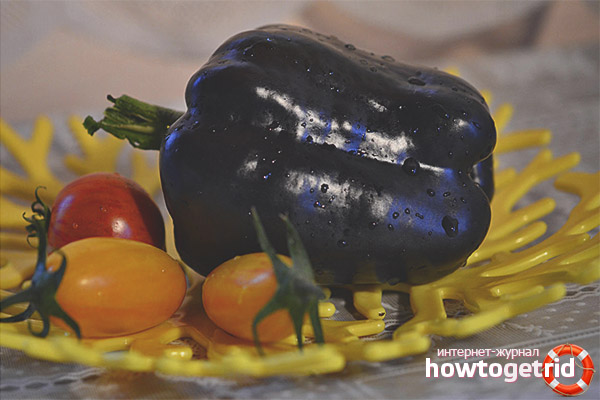The content of the article
Early ripe, rather high-yielding variety of sweet pepper with exotic black coloring of fruits. Harvesting can be carried out after 120 days from the moment of planting in open ground.
Grade description
The peel of a ripe fruit is painted in a saturated brown or black color. With proper agricultural technology and favorable climatic conditions, up to three kilograms of pepper can be collected from one bush. The iron content in combination with folic acid determine the high benefit of pepper fruits in case of anemia.
The Black Horse variety is not susceptible to diseases such as late blight and vertebral rot, and is also resistant to most pests of nightshade crops. Black fruits are ideal for fresh consumption and for canning.
Black horse pepper is ideal for commercial cultivation, as it is characterized by long shelf life and resistance to long-distance transportation.
Growing
The variety of bell pepper Black Horse is quite whimsical. In order for the plant to bring an abundant amount of the crop, it is necessary to begin its cultivation by planting pre-prepared seedlings. Particular attention should be paid to the site on which this crop will grow.
If you do not want to spend money on seedlings, then you can grow it yourself.
- The soil must be fertile, structured. There should be no drafts on the site.
- In the event that the pepper will be grown on poor soils, it will need regular fertilizing with organic fertilizers. Do not forget that you can grow pepper in the same area no more than once every three years. This culture greatly depletes the soil, it must be given time to recover.
- If you wish, you can increase the fertility of the soil by regularly adding peat, sand, humus, and turf soil to it.
- If desired, a small amount of wood ash and rotted sawdust can be added to the soil.
- Planting seeds is recommended in small peat pots.
- The plant responds positively to the addition of various complex fertilizers. It is desirable that the site is as protected as possible from wind loads.
- After all the necessary components have been introduced into the soil, it must be dug up in order to ensure uniform distribution of fertilizers.
- In the first days after planting in open ground, plants will need abundant watering. It is advisable to water these days with warm, settled water with the addition of wood ash.
Aisles are mulched with hay or sawdust to trap moisture in the upper layers of the soil.
Transplanting
Growing seedlings must begin 60 days before planting in open ground.
When four leaves appear on the seedlings, it can be planted in open ground. Planting seedlings on the site is carried out in late May, after the threat of spring return frosts has passed.
When planting seedlings, the air temperature should be at least 17 degrees. When arranging seedlings, keep in mind that more than three seedling bushes should not be located on one square meter. The root system of pepper is quite powerful. Too deepen the plants into the soil is not necessary, the first real leaves should be above the soil.
Watering is carried out under the root, otherwise there is a risk of sunburn. It is better to produce watering with frequent, but not abundant, because with abundant watering on the plant fungal diseases can develop. It is recommended to feed plants with organic fertilizers.
Experienced gardeners often face such a problem as drying out the soil. In order to prevent drying out, you can apply the procedure of mulching with dried grass residues, etc. The layer of mulch should not exceed 5 cm.
Mulch is replaced every month with a new one, otherwise there is a risk of various harmful organisms.
Ideal precursors for pepper are: legumes, tomatoes, onions, cabbage.
The Black Horse variety has an advantage: the fruits are not affected by gray rot, do not crack. Bell pepper seeds are stored for up to three years.
Video: how to form pepper










Submit